Fifty years ago this month at a radio exhibition in Berlin, a three-inch-by-four-inch product was unveiled. Half a century on, it doesn't look like much. But it was cheap, portable, easy to copy, and these simple, functional qualities held magic within them. They also helped the cassette revolutionise music for the masses, and shaped how music is used socially, creatively and psychologically.
CDs and downloads may have long superseded the humble C90, and its obsolescence seemed assured when Sony stopped manufacturing the Walkman in 2010. But against the odds, the cassette has whirred into fabulous life again, and on 7 September, an international event will celebrate its resurgence. At 25 venues in the UK and 50 others worldwide, Cassette Store Day will showcase the growing trend for cassette-only releases, with big labels such as Polydor and Domino getting in on the act, alongside little DIY startups.
For a format that was last the industry leader 22 years ago, it's not an inconsiderable achievement. There is still something in those spools that captures the imagination, a tangible, human connection around tape that makes us want to press play…
1 The compact cassette is unveiled – and revolutionises the album market

Tape for audio storage was first showcased at the Berlin Radio Show in 1935, on the reel-to-reel Magnetophon machine, but it would take another three decades for the stereo compact cassette to arrive. Dutch manufacturer Philips got there first in 1963, alongside the first battery-powered lightweight cassette player.
Albums on cassette arrived in the US in 1966, with Nina Simone, Eartha Kitt and Johnny Mathis among the first artists on tape; the UK followed suit in 1967. Intriguingly, cassettes also made the album a more significant format. As it was harder to select tracks on cassette than on record, listening to an album serially, without skipping, became ingrained in music culture. Cassettes also allowed more time for the album than vinyl. The standard LP length was 45 minutes in total; compact cassettes allowed up to 45 minutes per side.
2 Portable music arrives – and starts changing our brains
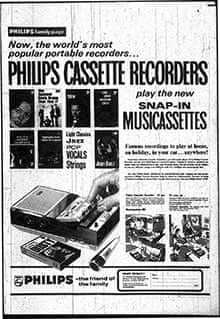
The Walkman is usually credited as the product that made people carry their music around with them. However, Philips was marketing the portable nature of its EL3301T cassette decks as early as 1966. They also had speakers, long before boomboxes and mobile phones pushed sounds out in public.
The arrival of the in-car cassette deck in the early 1970s is also often forgotten, turning every car journey into a sound-and-vision movie. In-car decks were also the first machines to have an "auto-reverse" function, allowing listeners to enjoy music on a loop without taking their eyes off the road. (The last car to have a cassette deck was manufactured relatively recently – the 2010 Lexus SC430 convertible.)
Raymond Macdonald, Professor of Music Psychology at Edinburgh University, believes that portable cassettes changed the very way we thought about ourselves. "Before going out and travelling with our music, we could now make psychological choices. How do I feel right now? How do I want to feel in five minutes? What kind of music is going to help me reach these goals? And if I'm on the train, who will overhear what I'm playing?"
This was a new psychological phenomenon, which became even more important with the advent of the compilation tape. "The cassette suddenly became a representation of your whole personality, a tool to make someone else feel the emotions that you feel. It also helped people create new narratives out of the music they liked, and by extension, of their lives. The cassette taught people a new kind of self-medicated therapy."
3 The underground tape market takes off (and makes some musicians money)
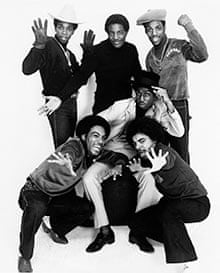
As blank tapes got cheaper to buy, musicians could record themselves more easily, without the need of a label to help them. This helped DIY genres such as post-punk, which had an active mail-order culture, and it also flourished in hip-hop, where it proved lucrative for some.
In the late 70s, Grandmaster Flash would charge a dollar a minute for customised "party tapes" for richer fans. He would shout out the buyer's name as part of his raps, and also give mixtapes to cab drivers who did "hold calls" – driving high-end clients around New York, without a destination, just to listen to music. In 2007, Flash told MTV that he used to make "a couple thousand dollars a month, easy, just doing this" – $6,000 in today's money.
Major labels in the UK also capitalised on the cool cachet of the cassette. In 1980, Bow Wow Wow were signed to EMI, and had a minor hit with the first ever cassette single, C30 C60 C90 Go. It featured the lines: "So I don't buy records in your shop/ Now I tape them all." In 1981, Island launched its short-lived One Plus One range, featuring a complete album on side one, and the same album again on side two – but crucially without copy protection, allowing fans to tape over the music. Albums in the range included John Martyn's Solid Air and U2's Boy, and the inserts read: "One side what you like. One side whatever you like."
The Dead Kennedys also adopted this idea on their late-1981 EP, In God We Trust, Inc. Printed on the blank B-side was the message: "Home taping is killing record industry profits! We left this side blank so you can help."
4 Music magazines find new life, on cassette
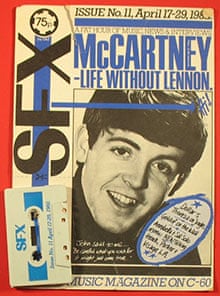
In November 1981, SFX Cassette became the first music magazine to exist not on paper, but tape. Young advertising executive Hugh Salmon set it up with NME journalist Max Bell, and it broke the mould in several ways. For instance, Salmon begged the Performing Rights Society to allow SFX to feature 20- to 30-second extracts of pop songs in every issue – predating the iTunes song-extract model by a few decades. "I remember convincing them that a clip would tempt someone into buying it, but wouldn't be satisfying enough to satisfy them totally," says Salmon. "Back then, it seemed like a radical argument."
SFX Cassette also grabbed incredible scoops, including one from Paul McCartney, Salmon says. "I remember one of McCartney's people just ringing Max, and Max going white, starting to shake." A fan of the magazine, McCartney wanted to speak to SFX about his reaction to the death of John Lennon – the very first time he had done so. The enterprising Salmon ran the interview over two issues.
The tape magazine closed in 1982 because of production costs, but cassettes thrived instead as give-aways on magazine covers. Compilations curated by journalists attracted extra readers for magazines such as Melody Maker and Select. In 1986, NME's C86 compilation featuring new bands on British indie labels also had a particularly long shelf life, propelling the rise of indie in the late 1980s, and featuring an opening track by Primal Scream.
5 Cassettes help music spread in the eastern bloc
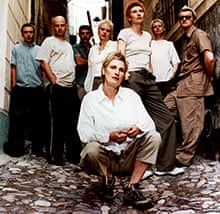
Music was heavily censored in iron curtain countries in the 1980s, but an underground cassette culture in Poland helped music to travel. In Poland, rock music wasn't banned as it was in other communist countries, but record releases were extremely rare. "Only a few bands were able to release things," remembers Wojtek Kozielski, who ran the RED tapes label in Wrocław in south-west Poland in the late 1980s. "And obviously, lyrics had to be approved by censors. Also, angrier, younger groups were never allowed to record in studios, and could only occasionally play festivals and small student clubs."
But when they did, the audience members brought their cassette recorders with them. A tape-swapping culture grew, on plain tapes, without artwork or track lists. Often, these recordings were taped over albums officially sanctioned by the government – mostly pop hits by Polish middle-of-the-road artists such as Krzysztof Krawczyk or Jerzy Połomski. Music fans used to tape over language lessons on cassettes as well – a practical necessity when blank tapes were hard to buy, but also a pointed act of resistance.
Soon, bands from the USSR, East Germany and Czechoslovakia were also being heard in Poland. Labels like Kozielski's also started releasing recordings by supportive artists from other countries, such as Holland's the Ex, and the UK's Chumbawamba. "There was even a plan to release a compilation tape of songs rejected by censors," Kozielski recalls. "But this never saw the light of day because of one very happy reason: the election in 1989, the first independent government since the war, and the end of censorship."
6 Alan Sugar helps end the 'Home Taping Is Killing Music' campaign
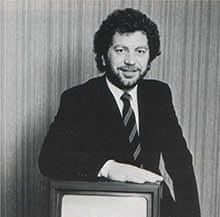
He may be better known now for firing corporate wannabes on his BBC TV show, but Alan Sugar was a big player in the 1980s cassette market. Having seen Sharp's twin-cassette deck – which allowed one cassette to be copied directly on to another – Sugar decided to develop one for the mass market. At this time, the BPI was running its famous Home Taping Is Killing Music campaign, following concerns that cassettes would aid the infringement of copyright and a decline in album sales. Sugar's twin-deck launch in 1987 was accompanied by an advert that said that copying was illegal, but CBS Songs nevertheless took his company, Amstrad, to court. They lost. The House of Lords ruled that "the defendant conferred the power to copy but did not grant the right to copy, therefore did not authorise the infringement" – ie manufacturers were not liable for the actions of their customers.
7 The live bootleg boom

London's Camden Lock Market was once full of stalls selling bootleg cassette recordings of gigs, a scene replicated, on a smaller scale, up and down the country. Some had inlays featuring band photos photocopied on to brightly coloured card, and many were made by a notorious bootlegger called Big Al.
A former colleague, Ian Macdonald, remembers him on Smiths fansite Smithstorrents.co.uk. "He was into bootlegging in a big way. He had farms of tape dubbing equipment, expensive industrial strength machines." Big Al had standards in other ways too. "If a Springsteen show finished at 11pm on Friday, Al could and would have 100 copies of it on sale the next morning in Camden and on Portobello Road."
The bootlegger would go up the front of the gigs with a WM-D6C machine – a 1980s Sony recording Walkman model, with Dolby C noise reduction – and put his head in the stacks, Macdonald recalls. However, Big Al disappeared from the business after a BPI raid on Camden Lock in 1987, in which "4,605 tapes with an estimated street value of more than £20,000" were seized, according to Music Week reports at the time. The live bootleg trade, however, carried on, albeit murkily, for the next decade.
8 The cassingle has its last hurrah
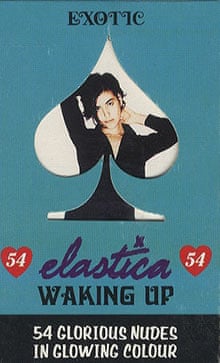
Between 1985 and 1992, cassette was the most popular format in the UK, before a small silver disc started ruining the party. The Britpop boom provided a last hurrah for the humble cassingle, a format dying in popularity as CD sales grew. Brian Cannon of the design company Microdot made one notable cassingle curio: the cassette version of Oasis's Cigarettes and Alcohol, made up to look, and open, like a packet of 20 cigarettes.
"It was an idea from the Creation marketing department, I think," says Cannon now, "although I'm sure Noel [Gallagher] would say it was his! There was so much money in the industry at the time, we could try anything with design." Cannon was given a template, and the rest was up to him – although the final product courted controversy at the time. "We were told we were glamorising smoking," Cannon remembers. "As if a 16-year-old boy would start buying cigarettes off the back of a single in a cardboard box!"
Another notable Britpop item was the cassingle version of Elastica's Waking Up, designed by Jon Anonymous: made up like a packet of cards, with a spade cut out of the front, it had a band member trading card inside.
9 The cult of the cassette returns, in fuzzy sound

In 2010, the same year that Sony stopped producing the Walkman, the Wall Street Journal published a piece about a new genre, chillwave. Chillwave was essentially fuzzily-recorded, 80s-inspired pop; music that sounded like it was recorded on to, and meant to be played on, tape.
Ernest Greene of Washed Out was one of its earliest practitioners, releasing his first EP, 2009's High Times, on to customised cassette. He told the Wall Street Journal how this act was a reaction towards anonymised culture. "The cool thing about cassettes is that they are made by hand and each one sounds slightly different, so it makes for a more personal experience," he said.
These feelings persist among other young musicians. Hardcore punk revivalists Loom are releasing a limited-edition album on cassette this month, featuring covers of 80s bands such as Jesus Lizard and Bad Brains. "The quality of cassettes lends them to the music we make," says singer Tarik Badwan (brother of singer Faris from the Horrors). "But you've got to look after cassettes too. It takes more care to make a cassette, do the artwork, store it and keep it. You don't forget about it like music on your computer."
He thinks younger music fans are craving a deeper relationship with the way music sounds too. "People are fed up with things being shiny and polished, or fake-raw – through-the-effects-desk-raw. People want to hear things that are rough and more real."
10 The rise of the cassette labels – and Cassette Store Day
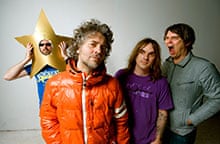
Cassette Store Day co-founder DJ Jen Long expected the event to be a one-off celebration at London's Rough Trade East shop – not an international operation running in shops in the UK, the US, Scandinavia and Argentina, involving more than 30 major and independent labels. "We're in shock," she says. She began her own cassette label, Kissability, in 2011, but says she knows why cassettes still appeal over other formats. "CDs feel like a thing you buy at a show to get your songs on to your computer. They're a middle man. MP3s don't feel as exciting to me as putting out a physical product either – you're not waiting for them to arrive at your door, or giving them to a band for the first time, putting them in your tape deck, hearing it play." The sound also has a certain appeal - Bobby Gillespie is quoted on the Cassette Store Day website praising tapes' 'warm and fat' quality, and their 'unique bottom end'.
Tapes are also much cheaper to put out than vinyl, adds Long, and in a tough economic climate, this means that cassette labels can take more risks. (With vinyl production, labels also have to make at least 250 copies; with tapes, release volumes can be small, and more exclusive.)
Long's not the only one doing this either. While sales figures are still miniscule, hundreds of new cassette labels have begun over the past few years; her favourites include Suplex, Reeks of Effort and Sexbeat, which is releasing a Cassette Store Day exclusive by Polaris music prize winners Fucked Up. Limited-edition cassette releases by bigger artists are on sale too. The Flaming Lips are releasing their recent album on tape for the occasion, while Haim are rereleasing their debut EP, Forever.
There is nostalgia in the mix too, Long admits, although she's quick to quash any criticism of the revival being a hipster fad. "We're putting out bands that we love. We're celebrating music that we love! It's about doing something that makes economic sense, that makes us all happy. Tapes involve effort, you know? They always have."
Cassette Store Day is on Saturday 7 September
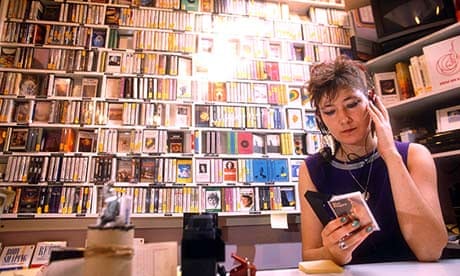


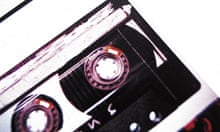

Comments (…)
Sign in or create your Guardian account to join the discussion